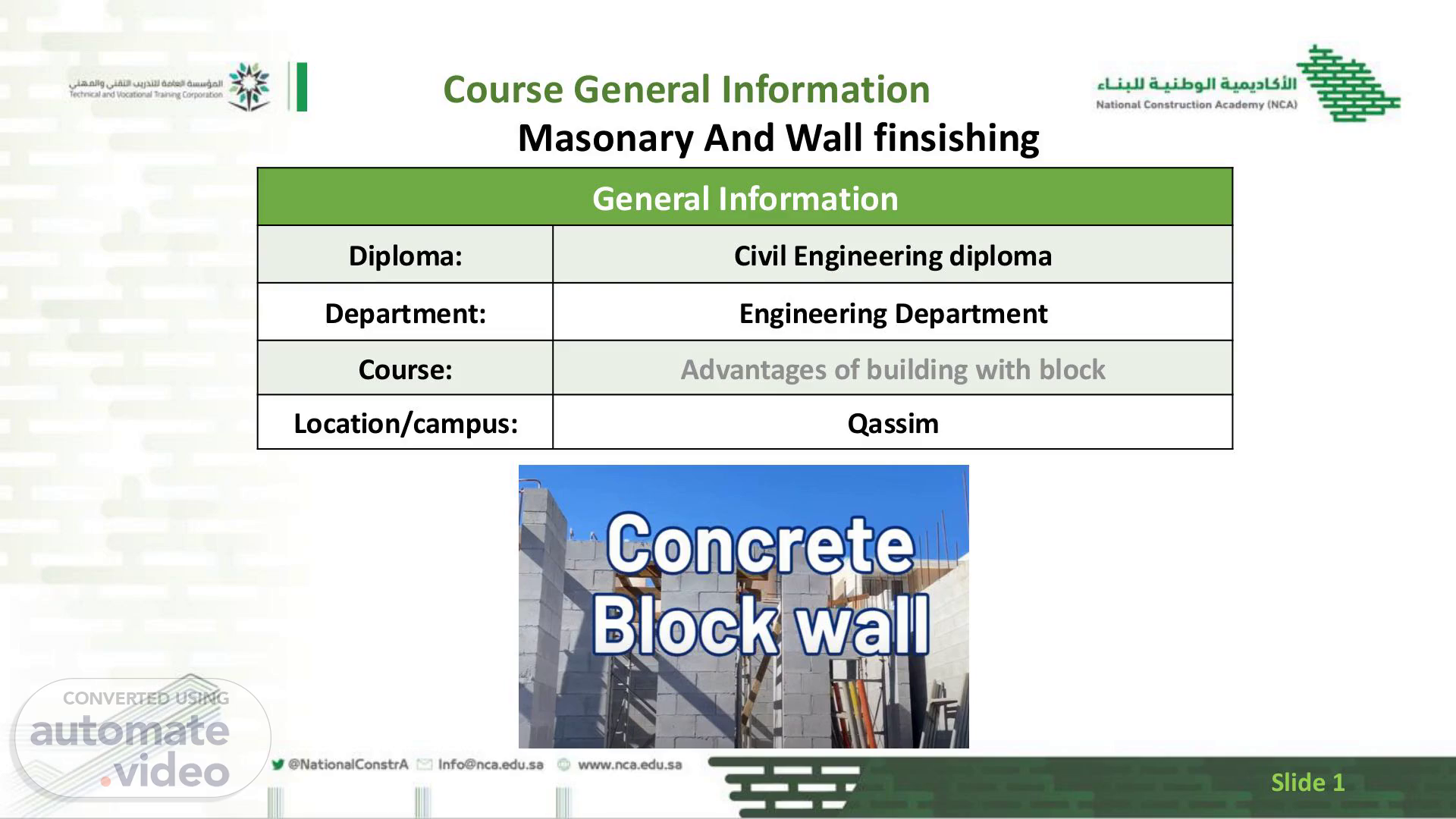Scene 1 (0s)
[Audio] Course General Information Masonary And Wall finsishing General Information Diploma: Civil Engineering diploma Department: Engineering Department Course: Advantages of building with block Location/campus: Qassim Slide 1.
Scene 2 (18s)
[Audio] Introduction Block construction involves using large, modular blocks made from materials like concrete and cinder to create durable buildings and structures. This method is favored for its strength and versatility, making it suitable for various applications, from homes to commercial spaces. Additionally, block construction allows for creative architectural designs while promoting efficiency and sustainability in the building process. Slide 2.
Scene 3 (50s)
[Audio] Lesson Objectives Demonstrate Durability: To showcase how block construction provides a long-lasting solution that withstands harsh weather conditions and reduces maintenance needs. Explain Cost Efficiency: To highlight how building with blocks can lead to lower initial material costs, reduced labor expenses, and long-term savings through lower maintenance and energy bills. Illustrate Energy Efficiency: To explain the thermal insulation properties of block materials that help regulate indoor temperatures, contributing to energy conservation and cost savings. Showcase Versatility: To emphasize the adaptability of block construction for various architectural designs and building types, making it suitable for residential, commercial, and industrial projects. Highlight Safety Features: To outline the enhanced safety and security benefits of block construction, including fire resistance and structural integrity against natural disasters. Slide 3.
Scene 4 (1m 54s)
[Audio] 5 Key words Thermal Mass: The ability of a material to absorb and store heat energy, influencing indoor temperature regulation and energy efficiency. Monolithic Structure: A construction method where a building is created as a single, unified mass, enhancing strength and durability. Reinforcement: The addition of materials (like steel bars or mesh) to increase the tensile strength of block structures, improving their resistance to cracking and structural failure. Modular Construction: A building technique where structures are prefabricated in sections (modules) that are then transported and assembled on-site, allowing for faster construction. Sustainability: The practice of designing and building structures in ways that minimize environmental impact and resource consumption, promoting long-term ecological balance. Slide 4.
Scene 5 (2m 52s)
[Audio] Slide 5. Slide 5.
Scene 6 (2m 57s)
[Audio] durability Key Points: Resistance to weather elements (rain, wind, fire). Long lifespan compared to traditional materials. Minimal maintenance required. Slide 6.
Scene 7 (3m 11s)
[Audio] Efficiency Key Points: Excellent thermal mass properties help regulate indoor temperatures. Reduced heating and cooling costs. Potential for energy-efficient design with insulation. Slide 7.
Scene 8 (3m 26s)
[Audio] Cost effectiveness Key Points: Lower material costs compared to wood or steel. Fast construction times lead to reduced labor costs. Long-term savings due to durability and low maintenance. Slide 8.
Scene 9 (3m 41s)
[Audio] Cost effectiveness Slide 9. Cost effectiveness Slide 9.
Scene 10 (3m 47s)
[Audio] Quicker construction Key Points: Faster assembly compared to traditional framing methods. Less reliance on skilled labor for installation. Can lead to shorter project timelines and quicker occupancy. Slide 10.
Scene 11 (4m 1s)
[Audio] Thermal insulation Key Points: Excellent thermal mass properties help regulate indoor temperatures. Reduces reliance on heating and cooling systems. Potential for energy-efficient design that lowers utility bills. Slide 11.
Scene 12 (4m 19s)
[Audio] Thermal insulation Slide 12. Thermal insulation Slide 12.
Scene 13 (4m 25s)
[Audio] Recap questions What are some key advantages of using block construction compared to traditional building methods? How does block construction contribute to energy efficiency and cost savings? In what ways can the versatility of block materials enhance architectural design? What safety features make block construction a preferable choice in certain environments? Slide 13.
Scene 14 (4m 49s)
[Audio] Conclusion In summary, building with blocks offers numerous advantages, including exceptional durability, cost efficiency, and quicker construction times. The thermal insulation properties of blocks contribute to energy savings, making them an environmentally friendly choice. Their versatility allows for a wide range of design options, accommodating different architectural styles and building types. Given these benefits, block construction presents a compelling option for anyone considering future building projects. Slide 14.
